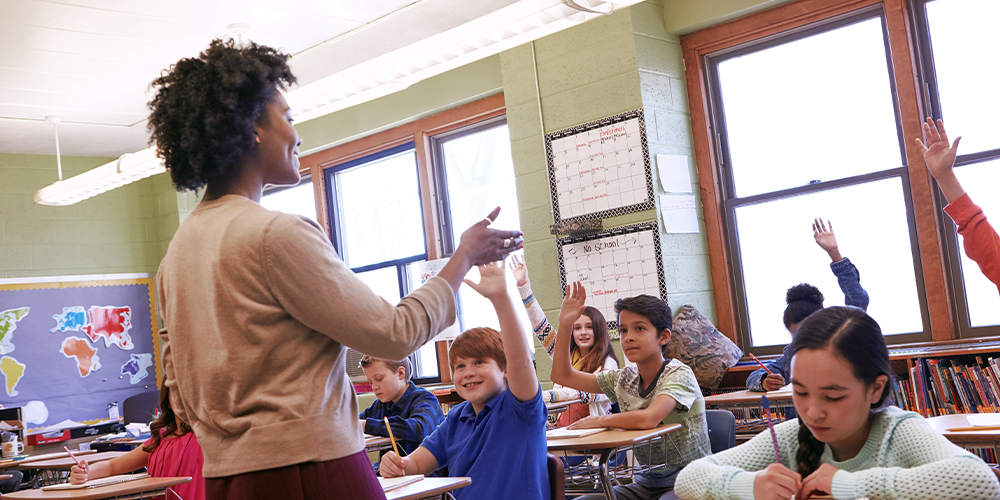I’ll admit it. I love being in a classroom where students are front and center! Watching students laugh, smile, engage, and communicate in person creates a specific energy and enthusiasm that is hard to replicate in front of a computer. We know the importance of academic growth, but those frequent chances to foster creative thinking and social interactions are just as important.
The COVID-19 pandemic directly impacted how students were offered opportunities to flourish. Even when a small minority of students and staff were successful during the pandemic, my experience from speaking with many other educators and leaders is that they felt the same way. It’s one reason the pandemic was so challenging from an educational perspective. While every educator dealt with remote learning uniquely, losing valuable time with my students helped reinforce my belief that social and emotional learning isn’t some catchy phase or something optional for effective teaching. SEL, as it’s often called, is required for optimal learning to occur.
I recall a situation where I was teaching an early morning class from home. It was 7:30 a.m., and my class of primarily 11th and 12th-grade students were joining our Google Meet. Luckily, I’d had some of these students in person, so making those initial connections was easy. Even with those strong bonds already formed, remote learning made further learning much more challenging. More specifically, it was daunting to re-create those meaningful conversations and lessons that go beyond the typical types of assessments and learning in class. Many students were easily disengaged through no fault of their own. Their learning experiences were partly disrupted by the challenges of creating that dynamic SEL classroom space.
The data from the National Center for Education Statistics highlights a wide variety of information about the effects of COVID-19. One key data point is that 87% of schools reported that social and emotional development was influenced negatively.
This speaks to how social-emotional learning plays a crucial role in the development of all students, especially post-COVID, where many experienced significant disruptions to their education and academic growth. Doing a little research makes it easy to find many suggestions for implementing SEL. The seven ideas below give you practical and authentic ways to implement SEL in your schools.
- Acknowledge and address trauma: The pandemic has profoundly impacted people’s mental health and well-being. We must recognize that individuals may have experienced trauma and incorporate trauma-informed approaches into SEL programs. This involves creating safe and supportive environments and providing resources to help students process their experiences. The following is an excellent resource concerning Trauma Informed SEL.
- Foster resilience: Promote risk-taking, judgment-free classrooms, and open dialogue so students develop resilience skills to navigate uncertain and challenging situations. SEL is foundational for building skills such as problem-solving, self-regulation, and optimism, which enable students to bounce back from adversity and adapt to new circumstances. For those interested, Casel provides an excellent starting spot for lesson planning.
- Emphasize self-care and well-being: COVID should have taught all staff that self-care, and wellness are part of everyday instruction. Engaging in activities that showcase mental, emotional, and physical well-being, such as mindfulness exercises, physical exercise, and social interactions, is scientifically shown to improve learning and socialization.
- Strengthen social connections: Foster positive social connections and relationships among individuals. Encourage peer support, collaboration, and empathy. SEL can allow individuals to share their experiences, listen to others, and develop a sense of belonging and community.
- Cultivate emotional intelligence: Help individuals develop emotional intelligence skills, including self-awareness, self-management, empathy, and relationship building. Effective programs can provide tools and strategies to identify and regulate emotions, understand others’ perspectives, and build positive and meaningful connections.
- Encourage reflection and meaning-making: Provide lessons that help students to reflect on their experiences during the pandemic and make meaning out of their challenges. Building those solid relationships can provide opportunities for personal reflection, goal setting, and envisioning a positive future.
- Evaluate and adapt: Continuously evaluate the impact of SEL programs and make necessary adjustments based on feedback and outcomes. Flexibility and responsiveness are essential in adapting SEL approaches to the changing needs of individuals in the post-online learning environment.
Remember that implementing SEL in any class or school requires a comprehensive and holistic approach to learning. We must always consider the unique challenges and experiences of all students. By prioritizing relationships, we can support students in navigating the emotional and social complexities in our classrooms.
I encourage all staff, no matter their role, to consider that SEL is never a one size fits all approach. As an SEL liaison in my school, any positive change is never just one lesson, evaluation, or something done as simply a check-the-box way of bridging SEL into our classes.
Social and emotional learning must be part of the daily instructional approach to teaching and learning. It is also an essential part of a well-rounded education. As our students navigate throughout their formative years, COVID-19 has taught us how critical the physical, social, and cognitive areas of learning are for students to be successful.
For educators interested in furthering their knowledge of SEL practices, Casel offers a template for learning more about how implementation is a viable option in schools. Please consider the following resource as a guide to building your program. Please contact me with questions about starting SEL in your schools or to help broaden their scope.
Best wishes for a great beginning to your school year!
Craig








